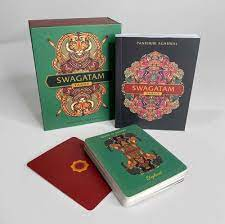Welcome to the Swagatam Tarot. The word swagatam means “welcome” in Sanskrit, one of the most ancient languages in the world. Based on Indian culture combined with the philosophies of Hinduism, the rich and unique images of this 92-card deck invite you to explore concepts of healing and self-exploration that have been around for centuries. The aces represent mudras, or hand gestures explained through the card images, which act as foundations to your work with yourself and others. An additional Minor Arcana suit, the suit of Smoke, completes the energy of the deck with the fifth element of ether, encompassing space and sky.
Those new to Tarot as well as seasoned readers will find this engaging deck an important tool for gaining insight into self-development and well-being. As well as providing keywords and card descriptions, the accompanying guidebook provides an elemental and lifestyle spread to provide balance and overcome challenges. Immerse yourself in the “swag” of this deck, with its rich, cultural delight, for a diverse and in-depth divination experience.
The Swagatam deck is available now, published by REDfeatherMBS. You can see the unboxing and flickthrough videos on Tiktok.
The first thing to say; in it's initial printing, this deck had a couple of problems, including wrongly aligned cards and duplicate cards in some decks. This new printing has none of those problems; every card was perfectly aligned and a joy to use.
While not perfectly square, these cards are more square than the usual tarot card, and they fit very nicely in my hands. They come in a box with a magnetic closure on the right hand side, with the LWB just inside and the cards nestled in a well under it. The LWB starts with an introduction to the deck and a couple of spreads before we're into the meanings.
Before we go any further, let's talk about the deck, as there are a couple of things that set this deck apart from other Tarot decks. First, there's an extra Minor suit, the suit of Smoke. The book points out that most cultures began with a belief in five elements, not four, and that Smoke can be mentally renamed to whatever the fifth element is in your belief system. So aether, spirit, metal, whatever is appropriate to you.
The other thing that sets this aside is that the Minor suits are divided numerically, not by their suits. So, for instance, all the Aces are traditional Indian hand gestures; Fours are natural dyes and what they symbolise; Sevens are geographical features, and so on. It's a really intriguing way to look at the structure of a deck.
Back to the LWB. After the spreads (two spreads designed for this deck) we're into the card meanings. Every card in the deck has the same layout: a full page image of the card on one page, and on the facing page keywords for upright and reversed meanings and an explanation of the Indian belief that corresponds to the card. For example, the Hierophant is pared with Niyam, which are the rules for right living; Judgement is Moksha, the liberation of the soul from the reincarnation cycle. It's fascinating stuff to read even without the tarot connection!
In the Minors, they are arranged by number instead of suit, so all the Aces, then all the Twos etc. The first card in each set, always the Cups, also has a quick description of what that number represents. Otherwise the information is the same as the Majors.
If I have any problem with this deck, it's this; the only meanings given are the keywords, nothing more in depth, and there's a whole suit here that will never be in any other deck so there's no other way to get meanings for it. However, as I worked with them I was starting to grasp the deeper meanings, so I think with some time and patience I would definitely get there. It's certainly not a deal breaker for me, just something to be aware of.
Now, the cards! They feature this reversible back design:
Major cards feature their name printed across the top, and both the Indian and English words for the associated concept in a handwriting style font across the bottom. There's no deck number on these cards. Minors have their number and deck printed across the top and the Indian word for their concept printed across the bottom. Some of the images have a frame while some are free floating; almost none of them approach the edges of the cards anyway.
Majors are a mix of background colours, mostly fairly subdued but a couple of bright ones. Minors have the same background colour across the same number, so all the Twos are black, the Eights are brown and so on. It's an extra way of identifying your cards and helps to unify them through the suits.
I had some trouble narrowing down my favourite cards, but here's a (small!) selection:
As this deck is not based on the RWS, I don't know how suitable it would be for a complete beginner; but then again, learning all the suits at the same time, including Smoke, might be easier than adding Smoke on afterwards! It's certainly a very beautiful deck, and while working with it I often stopped to study an image and learn more about the concept associated with it.
My usual querants found the artwork intriguing. They said that the meanings were not always straightforward, but with some thought they were always explainable. So this is maybe not a deck for a quick one card draw, but if you have time to really think about the spread, this is a fantastic one to choose. I've really enjoyed working with it and expanding my knowledge, and I'm excited to incorporate it into my work going forward!



















No comments:
Post a Comment